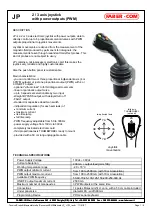
40
Rockwell Automation Publication 1766-UM002E-EN-P - June 2019
Chapter 7
User Provided Pages
· to reference a page on another processor, specify a URL such as
http://www.xxx.yyy.zzz/user2.htm
, where www.xxx.yyy.zzz is the IP address
of the controller
· you can reference other WWW servers and display images from other
sources without affecting your usage of data table memory (except for the
size of the HTTP reference)
Referencing Data Table Memory
- reference data table memory locations by
placing custom tags into your HTML source which specify the data table
location and optional formatting information. Use the following format for the
custom tag:
<!ABDTR-file_type{file_number}:{file_element}[,#elements][%format]>
The items surrounded by {} are sometimes optional. The items surrounded by []
are always optional.
You must always specify the basic file reference. Depending on which file is being
referenced,
file_number
or
file_element
may be defaulted. If the
file_type
is I, O or
S, the
file_number
does not need to be specified, but the
file_element
must be
specified. If the
file_type
is not one of the three special files, the
file_number
must
be specified and the
file_element
may default to zero (the input, output, and status
files have fixed file numbers).
When defining your custom tag, consider the following:
Tag Item
Description
#elements
If not specified, this defaults to one. If it is less than one, it also defaults to
one. Each element is output using the same format (whether specified with
%format or defaulted).
%format
Legal values are
%
d for decimal and
%
x for hexadecimal. The following file
types allow the format to be specified
·
Input
·
Output
·
Status
·
Integer
·
Timer
·
Counter
·
Control
·
Long
Display format
defaults
Input and Output file elements are output in decimal format. Status file
elements are output in hexadecimal format with a leading
0x. Integer file
elements are output in decimal format. Complex data types (Timer, Counter,
Control, or other data types) are output as a table with bits and important
words specified.
Fixed display formats
Float files are always output in floating point format (“C”%g format). ASCII
and STring files are always output as a null terminated text string. Binary
files are always output as two binary bytes.









































